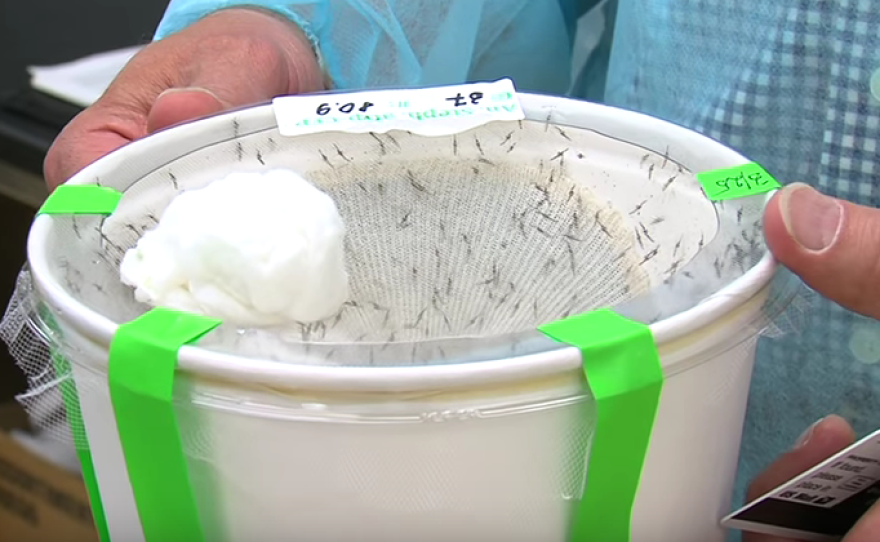Less than a year ago, UC San Diego scientists discovered a way to turn every fruit fly in their lab yellow by rewriting the rules of genetic inheritance. Now, new research shows their method can also spread disease-blocking genes through mosquitoes, making them malaria-proof.
In a study published Monday in PNAS, scientists delivered anti-malaria genes to more than 98 percent of the mosquitoes in their lab over a short period of time, relying on a "gene drive" to pass down the genetic change from generation to generation.
The results suggest gene drives could be a powerful new tool in the fight against malaria, a disease that killed 584,000 people in 2013.
"It does look like it's possible," said UC San Diego biologist and study co-author Ethan Bier, who helped develop the gene drive. "I think it'll galvanize many researchers to go forward very aggressively in this area and build similar kinds of genetic devices."
However, because gene drives could potentially alter entire populations of insects, experts say ethical and practical questions need to be addressed before using them in the wild.
The study in mosquitoes builds on a previous study in which Bier and his graduate student Valentino Gantz used a relatively new gene-editing tool called CRISPR to control genetic inheritance in fruit flies.
Gantz used CRISPR to cut and paste a gene into fruit flies that made them appear yellow. He also ensured those modified flies would pass down the yellow gene to their offspring. Their offspring then passed down the altered gene to all their offspring, resulting in a gene drive that turned essentially every fly in the lab yellow after a few generations.
When Bier saw all those yellow flies, he knew he had to call Anthony James, a scientist at UC Irvine dedicated to fighting malaria through genetic engineering. James ended up working with Bier on the new study, overseeing all the mosquito experiments in his carefully sealed lab at UC Irvine.
James had already genetically tweaked many different strains of mosquitoes to prevent them from transmitting malaria to humans through biting. But until now, he didn't have an efficient way of spreading his anti-malaria genes through entire mosquito populations.
"The very last line on his most recent paper was, 'Everything's ready to go, except we don't have a way of spreading it," Bier said, paraphrasing James's work. "We thought, well, we've got the motor. It's turned out to work much better than any of us expected it would."
James says the new mosquito study proves it is possible to move anti-malaria genes into the wild. Next, he hopes to carry out lab trials and "explore collaborative efforts with scientists in disease-endemic countries."
But releasing insects with rapidly spreading genetic modifications could be a controversial move in parts of the world where many people are already suspicious of genetically modified food.
In an email, James said it will be up to regulators and citizens in affected countries to determine whether they want to deploy gene drives against malaria.
"The science is ahead of the social developments," he said. "The latter will more likely dictate the speed at which the technology is applied."
Michael Kalichman, director of the UC San Diego Research Ethics Program, said in an email that the study is an exciting development in the fight against malaria, but some issues remain unresolved.
"Is it possible that the proposed genetic change will successfully move through the population, but that the change will also in some way make the species of mosquito less fit for survival?" Kalichman wrote. "There could be profound downstream consequences that we can't yet anticipate."
Kalichman said the threshold of public support needed to approve the use of a gene drive could be another thorny issue. If a slight majority of people in a given country like the idea, should the 49 percent who don't be forced to live alongside genetically modified insects?
"What sort of educational programs and informed consent process should be used to promote and hopefully obtain community support for the intervention?" Kalichman asked.
Others see a more sinister potential in gene drives. Officials with the Pentagon and the FBI are reportedly concerned that the technology could fall into the wrong hands and be harnessed to alter insects for even greater harm to humans.
Bier thinks it's unlikely terrorists will be interested in the difficult, time-consuming process of developing a malicious gene drive.
But he and other scientists are taking precautions for any negative consequences that could arise from a gene drive, he said. His lab is currently developing a way to overwrite a gene drive's original genetic modification should it go haywire.
All new technologies come with some risk, Bier said. But he thinks the benefits of fighting malaria would far outweigh the risks inherent with gene drives.
"In my personal view, it seems like a good risk to take," Bier said. "But the people who have to make that decision are the people who are in the region where the malaria is endemic."







